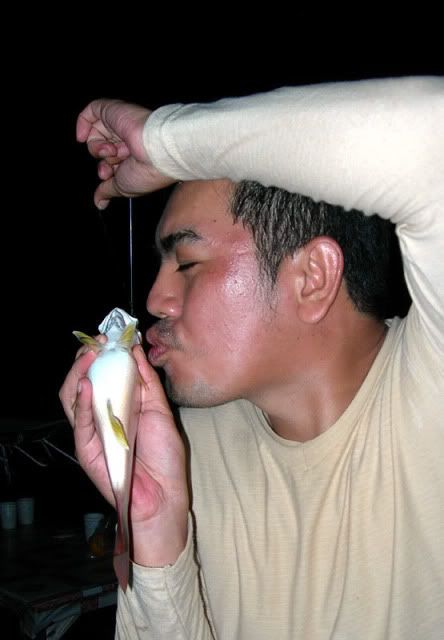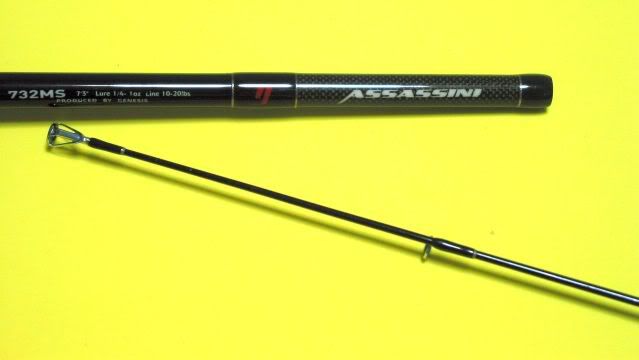 At tackle shop, whenever I manage to pick up a conversation between a newbie fisho and the tackle shop assistant, it is usually an interesting barrage of questions answered by some technical answers. I wonder at times how much can a newbie picks up these info and the frustration felt. Of course I can sense the frustration of the tackle shop assistant when these newbies are asking how to catch BIG fishes (maybe to impress the girl girl they are bringing along for the fishing trip), it's like trying to run before one learn to walk.
At tackle shop, whenever I manage to pick up a conversation between a newbie fisho and the tackle shop assistant, it is usually an interesting barrage of questions answered by some technical answers. I wonder at times how much can a newbie picks up these info and the frustration felt. Of course I can sense the frustration of the tackle shop assistant when these newbies are asking how to catch BIG fishes (maybe to impress the girl girl they are bringing along for the fishing trip), it's like trying to run before one learn to walk. As a matter of fact when I started fishing, my dad is always around to help me. He is a fisho too, and he will prepare everything I need for me and more. But in those days, money is hard to come by, we fish the most traditional way, handline on pier and lakes. Only in my twenties, then I started to fish with fishing rods and reels, and started a new chapter of learning on fishing once again. Allow me to share with you what I have learnt so far and to explain as much as I can the simple basic fishing methods.
Let's start off with the most essential items, the rod and reels. I will start with the most 2 common form of fishing locally, inshore baiting and light luring.
Rods
 It is actually hard to own one rod that does everything from inshore, offshore, luring, jigging, etc. Each specific form of fishing have it's own unique rod characteristic action it requires.
It is actually hard to own one rod that does everything from inshore, offshore, luring, jigging, etc. Each specific form of fishing have it's own unique rod characteristic action it requires.First, learn how to read the information on the rod. Namely, length, lure weight, line class. Starting to sound like rocket science? Fret not, I will try to explain as much as I can.
| Length | This indicate the overall length of the rod, i.e. when then rod is fully assembled. |
| Lure Weight | Range of lures weights the rod is able to cast, which also indicate the lead size it is able to cast. Some indicate in Grams but most are in Ounces. |
| Line Class | Recommended line class one should use with the rod, usually indicated in poundage. |
In summary, the main things you should be looking for is Length, Lure Weight, Line Class and Rod Action. In my view, for inshore baiting and light luring, my recommendation is as such.
| Reel type | So far I have yet to talk about it yet, there IS a difference between rod of a spinning reel and BC reel. Make sure you get a rod for spinning reels, which usually have a large guide before the reel seat. Also usually BC rod have a trigger handle reel seat, which will never appear on a spinning reel rod. |
| Length | Between 6ft to 8ft, it is easier to handle when you don't have the experience to cast a longer rod. |
| Lure Weight | Choose either 4g – 21g or 7g – 28g or there about, these range enable you to use most light lures and 1/2 to 1oz lead sinkers. |
| Line Class | Max of 15lbs would be enough for most application, if you are worried, choose one that have a Max of 20lbs |
| Action | Fast or Medium Fast; Since most rod are these action, simply reconfirm with the tackle shop. |
| Rod Material | Carbon Rods if the price is right; Usually carbon rods have a 'Lighting' warning label, this indicate a carbon rod. I will not go into details on different carbon content, but basically more carbon equates a lighter and stronger rod which is also more expensive. As there is no industry standard for most fishing equipments, thus for example, the carbon content of IM7 for one brand might differ from another. |
| Price | Pick one you can afford, unless you are sure you are going to do fishing for a long long time you can get a good one. Else there is a lot of good and affordable rods in the sub SGD80 category. |
Would seriously recommend a spinning reel for beginners, as it is much easier to operate.
 Baitcaster (BC) are more complex to operate as you will need to make adjustments to suit the wind, casting weight and rod. Choose a front drag reel as it offer a wider ranger of drag adjustment, and frankly much more choices too. You might say that a BC reel would look more 'sexy' to use, well anglers uses a BC reel for some reasons, like they need the accuracy of a BC reel, more line, more drag, etc. But it could be a pain in the arse if you cannot handle it as you will be spending time clearing the 'birdnest' rather then fishing.
Baitcaster (BC) are more complex to operate as you will need to make adjustments to suit the wind, casting weight and rod. Choose a front drag reel as it offer a wider ranger of drag adjustment, and frankly much more choices too. You might say that a BC reel would look more 'sexy' to use, well anglers uses a BC reel for some reasons, like they need the accuracy of a BC reel, more line, more drag, etc. But it could be a pain in the arse if you cannot handle it as you will be spending time clearing the 'birdnest' rather then fishing. Again, there are no standard industry standard for reels, a Daiwa or Shimano 1500 to 2500 sized reel will be suffice for most form of fishing. Most budget series form the above brands are reasonable fine as they are well designed and usually comes with an aluminum spool, do make a check on the bearing count as these affect the feel of smoothness of the reel. Of course there a other makes of good quality budget reels, do take you time and feel the reel before you make your purchase. Once you make your choice, do check if the drag system is working well, i.e smooth, unlikely to have any problem but you might never know. It could be just me as I am a big sucker for smooth drag system.
I haven't been checking the pricing of reels recently, I think there is a lot of reels are available in the range of SGD40 to 80. And trust me even though they are of budget series, they do last for a pretty long time, this Shimano Alivio reel I have been using for a few years already is still going strong. Any reel, be it budget or an high end reel will need to be serviced periodically, so if you do that, you will have no problem with the reel for a long long time. This the link to a simple reel service or if you want to a complete strip down to clean and re-lube.
Lines
Basically there are 3 type of lines material to c
 hoose from, superlines, fluorocarbon & monofilament. Superlines are thin, slippery and almost zero stretch., monofilament are the traditional choice, relatively much cheaper while fluorocarbon are a relatively new product that sits bewteen both in terms of properties, usually we will use this as a shock leader only, but in US they spool the entire reel with this line. If you ask me, if you have the spare budget after buying your rod and reels, choose the superlines (brands like Fireline, Power Pro, etc). Just get a spool of 150m or so will do, and get the tackle shop to put in some monofilament backing on the spool before they spool up the reel right to the brim with all of the superline, and have them to attach a short length of monofilament shock leader too if you are not sure how to do it.
hoose from, superlines, fluorocarbon & monofilament. Superlines are thin, slippery and almost zero stretch., monofilament are the traditional choice, relatively much cheaper while fluorocarbon are a relatively new product that sits bewteen both in terms of properties, usually we will use this as a shock leader only, but in US they spool the entire reel with this line. If you ask me, if you have the spare budget after buying your rod and reels, choose the superlines (brands like Fireline, Power Pro, etc). Just get a spool of 150m or so will do, and get the tackle shop to put in some monofilament backing on the spool before they spool up the reel right to the brim with all of the superline, and have them to attach a short length of monofilament shock leader too if you are not sure how to do it. As superlines have little scratch, it will burst easily when fishes make a sudden dash. The shock leader will help to absorb the sudden surge of force. Choose between 10 to 15lbs test strength for the superline and have a 20 to 25lbs shock leader.
That's about it for the basic of choosing a beginner set of fishing tackles for inshore and light luring, in fact it is good enough for table sized fishes too. And not forgetting this set up is also good for light fishing on kelongs too.
I will put up some of my fav simple rigs in future, nothing fanciful really. But if you are at a loss it might, just might help you to catch at least some small tiny fishes to kick start this hobby.

1 comments:
nice post. i love fishing but fishing in Yacht Charter Dubai is so cool. you should also try it.
Post a Comment